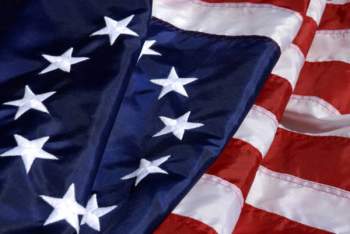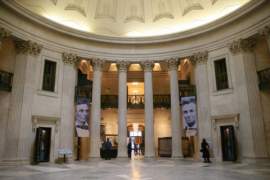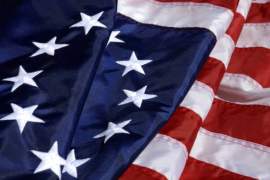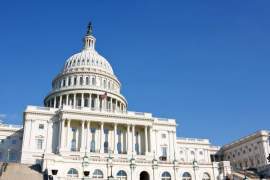
A Quick Guide to John Dickinson

Popular In Constitution
Purpose Of Lifetime Appointment And Pros And Cons Enumerated Powers Bicameral Legislature Background Article 3 Of The Constitution We The People 1st Amendment Who Wrote The Constitution Judicial Review Equal Protection Clause Three Fifths Compromise 10th Amendment 5th Amendment
Founding Father: John Dickinson
John Dickinson was born on November 18, 1732 at the Crosiadore estate, near Trappe in Talbot County, Maryland. John Dickinson was the second son of Samuel Dickinson, who was a prosperous farmer, and his second wife, Mary Dickinson. In 1740, John Dickinson’s family moved from Maryland to Kent County, Delaware. Here, private tutors were hired to educate the John Dickinson. In 1750, he started to study law in Philadelphia with John Moland. In 1753, John Dickinson travelled to England in order to continue his education at London's Middle Temple. After four years, he came back to Philadelphia and quickly became a prominent lawyer. In 1770, John Dickinson married Mary Norris, the daughter of a wealthy merchant.
By this time, John Dickinson superior talents and education had placed him into politics. In 1760, Dickinson had already served in the assembly of the Three Lower Counties, where he was the speaker. Combining his Delaware and Pennsylvania careers, he won a seat as a member in the Pennsylvania assembly in 1762 and sat for another term in 1764. John Dickinsona became a leader of the conservative group in the political battles of the colonies. His defense of the governor against the group led by Benjamin Franklin damaged his popularity but earned him respect from others for his integrity. Nevertheless, in 1764 he lost his legislative seat.
Meantime, the tension between the colonies and Great Britain had gotten stronger and John Dickinson had become a prominent Revolutionary thinker. In the debates regarding the Stamp Act of 1765, he played a vital part. The same year, John Dickinson wrote “The Late Regulations Respecting British Colonies Considered”, which was a very influential pamphlet that begged Americans to fight for repeal of the act by putting pressure on British merchants. Because of this, the Pennsylvania legislature made him a Pennsylvania delegate to the Stamp Act Congress.
Between 1767 and 1768, John Dickinson wrote a set of newspaper articles in the Pennsylvania Chronicle that later was collectively called Letters from a Farmer in Pennsylvania. These letters attacked the taxation policy of the British and urged the colonies to resist these unjust laws. The letters also emphasized the potential of a peaceful resolution. Because the letters were extremely popular in the colonies, John Dickinson was given an honorary LL.D. from the College of New Jersey along with public thanks during a meeting in Boston. In 1768, in response to the Townshend Duties, John Dickinson championed rigorous colonial resistance through the use of non-exportation and non-importation agreements.
In 1771, John Dickinson returned to the Pennsylvania legislature, where he drafted a petition intended for the king which was unanimously approved. However, because of his continuous opposition to the use of force, by 1774 he lost a lot of his popularity. He was extremely critical of the tactics used by New England leaders that year and refused to support any aid requested by Boston after the Intolerable Acts, although he sympathized with the plight of Boston. Reluctantly, John Dickinson was pushed into the Revolutionary fray. In 1774 he became chairman of the Philadelphia committee of correspondence and also briefly sat as a representative from Pennsylvania in the First Continental Congress.
Throughout 1775, John Dickinson supported the Whigs, but he continued to work for peace. Dickenson drew up many petitions questing redress of grievances from the king. At the same time, he also chaired a Philadelphia committee of safety and defense and also held a colonelcy in the very first battalion recruited to defend the city of Pennsylvania.
After Lexington and Concord, John Dickinson continued to wish for a peaceful solution. During the Second Continental Congress from 1775 to 1776, he drew up a Declaration of the Causes of Taking Up Arms as the representative from Pennsylvania. In the Pennsylvania assembly, he also drafted an authorization to send some delegates in 1776 to Congress. This draft directed them to look for redress of grievances, but also ordered them to oppose the separation of the American colonies from Great Britain.
By this time, John Dickinson’s moderate position had made him a member of the minority. In Congress, Dickinson voted in 1776 against the Declaration of Independence and. He refused to sign it. Even so, he became one of two contemporary congressional members, the other being Thomas McKean, who enrolled the military. When John Dickinson was not reelected, he resigned his commission as brigadier general and went back home to his estate in Delaware. In 1776, he was his new constituency reelected him to Congress, but he declined the position and also quit from the Pennsylvania Assembly.
John Dickinson came out of retirement in 1779 to take a seat in the Continental Congress, where he stayed till 1780. Here he was a signer of the Articles of Confederation. Before this he was the head the committee which had drafted these articles. In 1781, John Dickinson became president of the Supreme Executive Council of Delaware. After a little while, Dickinson moved back to Philadelphia. Once back, he became president of Pennsylvania from 1782 to 1785. In 1786, John Dickinson represented Delaware at the Annapolis Convention, where he was a chairman.
The year after, Delaware sent John Dickinson to the Constitutional Convention. Because of his illness, he missed many of the sessions. However, he made many worthwhile contributions, such as his service as a member of the Committee on Postponed Matters. While he did not like the forcefulness of James Madison and many other nationalists, Dickinson helped create the Great Compromise and also wrote many public letters expressing support for the ratification of the Constitution. Because of his early departure from the Constitutional Convention, Dickinson was not actually able to sign the Constitution. However, he authorized his fellow-delegate and friend George Read to sign it for him.
John Dickinson lived for another two decades, but he did not hold any public offices during this time. Instead, Dickinson devoted himself to his writings on politics. In 1801, he published two volumes of his works. John Dickinson died at Wilmington on February 14, 1808 at the age of 75. He was entombed at the Friends Burial Ground.



















